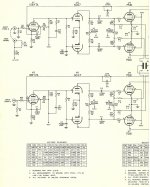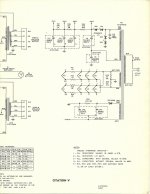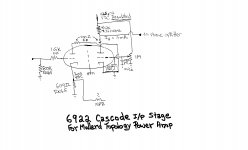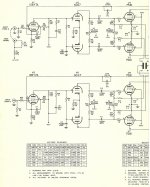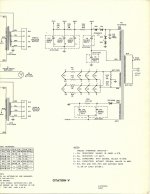right now in my listening room this computer is in i have a 36.356db noisefloor.
this room is dead silent built for this only.
that 36db is the fan in the pc.
playing dsd tracks right now i have about 69.71 db from speakers odd peak to 71db and this is drawing 42, 44 ish watts showing on my digital meter.
turn up to 79 db out drawing 50 to 53 watts.
any wonder why 35 watt st70 or 40 watt cary could not keep up, no
both in this quite room were over worked and clipped.
this forced me to turn down volume to protect amps.
it also force me to sale both
after all can i expect a 35 or 40 watt rated amp to make 100 watts ? not clean
but can a 100 watt or higher rated amp be expected to make 50 or 55 watts ? cleanly yes.
that is why i want power and glowing tubes.
my goal was to add 2 more kt88 to the w-6m so it may make 80 or what ever watts
because more is better then less even if more is not use.
100 watt would be perfect for me and my setup.
with that mindset see what i mean?
i just want a real world rating in watt and friendly build for a first build
this room is dead silent built for this only.
that 36db is the fan in the pc.
playing dsd tracks right now i have about 69.71 db from speakers odd peak to 71db and this is drawing 42, 44 ish watts showing on my digital meter.
turn up to 79 db out drawing 50 to 53 watts.
any wonder why 35 watt st70 or 40 watt cary could not keep up, no
both in this quite room were over worked and clipped.
this forced me to turn down volume to protect amps.
it also force me to sale both
after all can i expect a 35 or 40 watt rated amp to make 100 watts ? not clean
but can a 100 watt or higher rated amp be expected to make 50 or 55 watts ? cleanly yes.
that is why i want power and glowing tubes.
my goal was to add 2 more kt88 to the w-6m so it may make 80 or what ever watts
because more is better then less even if more is not use.
100 watt would be perfect for me and my setup.
with that mindset see what i mean?
i just want a real world rating in watt and friendly build for a first build
47k/910 pF? It is insane, like an opamp. 😀
What are you talking about, Anatoliy......
Oh there! Yes, jeepers. Pole at 3.4 KHz, perhaps 6 KHz bringing the rp in ..... then there is still the Miller effect of the 12AX7 - or perhaps because of it. I agree, something is wrong, seeing that the original Williamson circuit had an uncompensated (open loop) h.f. response of >40 KHz.
In general I would agree with keeping it simple, but not so simple that components are stressed. Not to befuddle the OP, but I myself prefer 4x 6L6GC in PPP; getting 110W out. (100W at low mains voltage dip.)
Could the impedance mismatch of 8 to 11.2 ohm play a role?my #1 build finish out at 11.2 ohm.
FWIW, I like the W6M's conceptual Class "AB2" variation on the Williamson theme, not the implementation details. The O/P "iron" Heath used was excellent, too.
The W6M's gain structure is wrong, especially when modern digital sources are taken into account. "Padding" the I/P signal down followed by "gobs" of gain certainly does not help S/N performance. Also, high gm small signal types are highly desirable inside NFB loops, as they provide resistance to HF error correction signal induced slew limiting. JMO, it's hard to envision a choice worse than the 12AX7/ECC83 for the differential gain block position.
The W6M's gain structure is wrong, especially when modern digital sources are taken into account. "Padding" the I/P signal down followed by "gobs" of gain certainly does not help S/N performance. Also, high gm small signal types are highly desirable inside NFB loops, as they provide resistance to HF error correction signal induced slew limiting. JMO, it's hard to envision a choice worse than the 12AX7/ECC83 for the differential gain block position.
FWIW, I like the W6M's conceptual Class "AB2" variation on the Williamson theme, not the implementation details. The O/P "iron" Heath used was excellent, too.
The W6M's gain structure is wrong, especially when modern digital sources are taken into account. "Padding" the I/P signal down followed by "gobs" of gain certainly does not help S/N performance. Also, high gm small signal types are highly desirable inside NFB loops, as they provide resistance to HF error correction signal induced slew limiting. JMO, it's hard to envision a choice worse than the 12AX7/ECC83 for the differential gain block position.
thanks brother
i'm not targeting the w-6m. i'm thinking now to just build a dyna mk 3
all this negative talk of the w-6m has me worried.
you all have to remember i don't know anything about circuit changes or terms
really i don't need to know , just follow direction, build and listen.
Last edited:
GKF,
Frankly, I don't think you will be happy with the no better than marginal MK3.
Most, if not all, of us here face budget realities. Quite nice results can be obtained from Mullard style circuitry and decent, if unspectacular, O/P "iron". IMO, the best "vintage" implementation of Mullard style is the H/K Cit. 5 (schematic uploaded). The Cit. 5 does use high gm small signal types. You could "copy" the Cit. 5 around Hammond 1650P O/P transformers. Roll the deep bass off just below 30 Hz. at the circuitry's I/P, to protect against core saturation. Please keep in mind that the lowest note a "standard" double bass plays is 41 Hz. 😉
You could "copy" the Cit. 5 around Hammond 1650P O/P transformers. Roll the deep bass off just below 30 Hz. at the circuitry's I/P, to protect against core saturation. Please keep in mind that the lowest note a "standard" double bass plays is 41 Hz. 😉
The 12BY7 the Cit. 5 employs as its voltage amplifier is out of production and, IMO, the available stock should be reserved for amps already in existence. That fact set is really a non-issue as I've uploaded a 6922 cascode voltage amplifier schematic that's specifically intended to dispose of the matter. 😀
Frankly, I don't think you will be happy with the no better than marginal MK3.
Most, if not all, of us here face budget realities. Quite nice results can be obtained from Mullard style circuitry and decent, if unspectacular, O/P "iron". IMO, the best "vintage" implementation of Mullard style is the H/K Cit. 5 (schematic uploaded). The Cit. 5 does use high gm small signal types.
 You could "copy" the Cit. 5 around Hammond 1650P O/P transformers. Roll the deep bass off just below 30 Hz. at the circuitry's I/P, to protect against core saturation. Please keep in mind that the lowest note a "standard" double bass plays is 41 Hz. 😉
You could "copy" the Cit. 5 around Hammond 1650P O/P transformers. Roll the deep bass off just below 30 Hz. at the circuitry's I/P, to protect against core saturation. Please keep in mind that the lowest note a "standard" double bass plays is 41 Hz. 😉The 12BY7 the Cit. 5 employs as its voltage amplifier is out of production and, IMO, the available stock should be reserved for amps already in existence. That fact set is really a non-issue as I've uploaded a 6922 cascode voltage amplifier schematic that's specifically intended to dispose of the matter. 😀
Attachments
Last edited:
GKF,
Frankly, I don't think you will be happy with the no better than marginal MK3.
Most, if not all, of us here face budget realities. Quite nice results can be obtained from Mullard style circuitry and decent, if unspectacular, O/P "iron". IMO, the best "vintage" implementation of Mullard style is the H/K Cit. 5 (schematic uploaded). The Cit. 5 does use high gm small signal types.You could "copy" the Cit. 5 around Hammond 1650P O/P transformers. Roll the deep bass off just below 30 Hz. at the circuitry's I/P, to protect against core saturation. Please keep in mind that the lowest note a "standard" double bass plays is 41 Hz. 😉
The 12BY7 the Cit. 5 employs as its voltage amplifier is out of production and, IMO, the available stock should be reserved for amps already in existence. That fact set is really a non-issue as I've uploaded a 6922 cascode voltage amplifier schematic that's specifically intended to dispose of the matter. 😀
ok this looks very doable. and not knowing about core saturation or roll back of deep bass. however, this is what i do now with a active sub sonic filter of sorts set at 35hz to keep deep bass out of speakers.
and i have some 6922 and 7305 high end left over from the dyna days.
i only mentioned the dyna mk3 due to ease of trannys available everywhere.
can we clear this up first
with this #5 in mind
can i just add 2 more tube to the design?
or do adding make power tranny needs more rail voltage?
can i just add 2 more tube to the design?No, going PPP requires different (1/2) primary impedance that can handle 2X the power and, naturally, UP go the costs. Also, the 3 dB. difference between 50 W. and 100 W. is barely audible. Twice as loud as 50 W. requires (sic) 500 W.
Build with PSUs that have cojones and you'll have 3 dB. of dynamic headroom at your disposal.
Never, ever, forget that perfection is an enemy of the good. Settle for very good, at a price you can afford.
GKF, lose the pc for a iphone or tablet device so your noise floor is 3 -5 db.
it also sounds like your speakers are very inefficient. 90db/w per meter speakers will yield 106 db using a 30 watt per channel amplifier.
it also sounds like your speakers are very inefficient. 90db/w per meter speakers will yield 106 db using a 30 watt per channel amplifier.
GKF, lose the pc for a iphone or tablet device so your noise floor is 3 -5 db.
it also sounds like your speakers are very inefficient. 90db/w per meter speakers will yield 106 db using a 30 watt per channel amplifier.
100 % no
as stated i want what i want . i will not settle for less
i have 348gig of mp3 flac and dsd only other source is turntable
as far as speakers go no
these will never leave the 10" x 14" foot print they sit in now
if tube can't do what i need then it's not for me
ok this looks very doable. and not knowing about core saturation or roll back of deep bass. however, this is what i do now with a active sub sonic filter of sorts set at 35hz to keep deep bass out of speakers.
If you are blocking info. below 35 Hz. now, an additional rolloff is not needed. 🙂 Are you using a subwoofer in combination with your main speakers?
MP3 sucks, as lots of info. was discarded during the compression process. AFAIK, FLAC is lossless and you should do fine with it.
IIRC, the exact speakers being used have not be specified clearly. That info. is needed in order to make rational recommendations/choices. The speakers may be tube "unfriendly" to the point that the best setup is a good SS power amp combined with a nice tube preamp.
BTW, executing a tubed line stage is a MUCH easier project, both technically and financially, than a sophisticated power amp build.
A turntable was mentioned. What do you use for a phono preamp?
turntable is a 1979 heybrook tt2 rega rb300 arm modded rewired with 1877 tonearm wire.phono preamp is a mm one i built myself.If you are blocking info. below 35 Hz. now, an additional rolloff is not needed. 🙂 Are you using a subwoofer in combination with your main speakers?
MP3 sucks, as lots of info. was discarded during the compression process. AFAIK, FLAC is lossless and you should do fine with it.
IIRC, the exact speakers being used have not be specified clearly. That info. is needed in order to make rational recommendations/choices. The speakers may be tube "unfriendly" to the point that the best setup is a good SS power amp combined with a nice tube preamp.
BTW, executing a tubed line stage is a MUCH easier project, both technically and financially, than a sophisticated power amp build.
A turntable was mentioned. What do you use for a phono preamp?
now system preamp is a goldpoint pot in a diy pre i built power amps now are rod elliot p101 mono block 150 watts and currently building 2 slew monster mono blocks .
i have in the past had tons of different equip . one was a counterpoint sa2000 tube preamp and it was very modded by alta vista.
if audio research have a 200 watt 6 tube power amp and bob latino has m-125 125 watt 4 x kt88 amp
why for the love of peat can't i find any listed with values for normal power transformer.
i would build the genalex 100 watt but it has the stupidest power trans listed
it has 5v @7a 700v x 2 @326ma 6.3 @ 5a and 75v @10ma
every single high power claimed schematic i look at either is value blank or a insane priced one off.
is there nothing out there that uses a normal off the shelf transformer?
Tubes are very much a niche market. If it wasn't for guitar pickers, nobody would be currently making tubes. The magnetics needed have always added to the costs and the few people left that know how to construct "esoteric" "iron" deal in low volumes. The economies of scale are not available to us, in this hobby.
A watt is a watt, but tube amps, unlike SS stuff, can safely be pushed right up to the clipping point. Tube amps compress, before hard clipping sets in and your tweeters get fried. I think you might be very pleasantly surprised by a Cit. 5 "copy", with a really good PSU. You will have dynamic capability of 100+ W. Continuous power will be around 50+ W., but music is transients. 😉
Do you happen to know what the impedance curve of your speakers looks like? Sometimes, like big Thiels, the impedance dips are so nasty as to make tubed power amplification a very bad choice. Proper mating of power amplification and speakers is a critical piece of the superior system puzzle.
A watt is a watt, but tube amps, unlike SS stuff, can safely be pushed right up to the clipping point. Tube amps compress, before hard clipping sets in and your tweeters get fried. I think you might be very pleasantly surprised by a Cit. 5 "copy", with a really good PSU. You will have dynamic capability of 100+ W. Continuous power will be around 50+ W., but music is transients. 😉
Do you happen to know what the impedance curve of your speakers looks like? Sometimes, like big Thiels, the impedance dips are so nasty as to make tubed power amplification a very bad choice. Proper mating of power amplification and speakers is a critical piece of the superior system puzzle.
eliTubes are very much a niche market. If it wasn't for guitar pickers, nobody would be currently making tubes. The magnetics needed have always added to the costs and the few people left that know how to construct "esoteric" "iron" deal in low volumes. The economies of scale are not available to us, in this hobby.
A watt is a watt, but tube amps, unlike SS stuff, can safely be pushed right up to the clipping point. Tube amps compress, before hard clipping sets in and your tweeters get fried. I think you might be very pleasantly surprised by a Cit. 5 "copy", with a really good PSU. You will have dynamic capability of 100+ W. Continuous power will be around 50+ W., but music is transients. 😉
Do you happen to know what the impedance curve of your speakers looks like? Sometimes, like big Thiels, the impedance dips are so nasty as to make tubed power amplification a very bad choice. Proper mating of power amplification and speakers is a critical piece of the superior system puzzle.
yes sir and that is the right question
8 ohm speakers can at times dip to 3.4 ohm
4 ohm speakers can dip to 1.7
my multi driver speakers dip to never lower then 7.4 ohm
higher impedance speakers will always take more power to drive but are safer to amps with no low dip.
11.2 ohm is not high anyway . that is why there is 16ohm taps .
alot of vintage drivers are 8 ohm, 10 ohm, 12 ohm and 16 ohm i have even bought 1950's 12" full range drivers that were 20 ohm.
i will build anything but what do you mean by cit.5 copy with a really good psu?
if you mean values other then on the schematic.
in the end i want to get this going. everything has to be ordered so lets get a design with values stated and build something.
harman kardon citation 5....

eico hf-89:

http://sanacacio.net/hifi/hf89schematic.jpg
you can give these vintage amps a modern twist, like a CCS instead of a resistor in the tail of the LTP phase splitter....and if you can hunt down the opt irons, then that will be very good...

eico hf-89:

http://sanacacio.net/hifi/hf89schematic.jpg
you can give these vintage amps a modern twist, like a CCS instead of a resistor in the tail of the LTP phase splitter....and if you can hunt down the opt irons, then that will be very good...
"i will build anything but what do you mean by cit.5 copy with a really good psu?"
We can go the monoblock route. Better diodes and caps. are available today than H/K was able to source/afford in the 1960s. H/K left a choke out of the Cit. 5 PSU, but we will not. The Cit. 5 was the low priced amp of the tubed Citation line. The Cit. 2 was the "balls to the wall" model, but getting the "iron" of the quality used in the "Deuce" today will cost you both money and body parts. 🙁 An Antek AS-2T350 power trafo in each monoblock will provide ALL the cojones needed and then some. Can't beat AnTek prices! We will bridge rectify the B+ with "noiseless" Schottky diodes.
You already know the Hammond O/P trafo to be used. Stay with the Hammond theme and use 1 of their 159T chokes in each chassis.
Time find a Canadian Hammond dealer with the best prices and order the O/P transformers and chokes. Order the power transformers directly from AnTek.
We'll deal with diodes, tube sockets, and passive parts very soon. The only possible additional "iron" that could be needed would be associated with negative rails and we might be able to voltage multiply 1 of the AnTek toroid's 6.3 VAC windings to satisfy that need.
I previously uploaded the voltage amplifier schematic.
A "modern" improvement for the LTP phase splitter is to constant current sink (CCS), instead of resistively, load its "tail". A 10M45S integrated circuit is quite adequate here.
Remember what I said about high gm and slew limiting. The 6CG7 will be changed to the higher gm ECC99.
Great! Configure the O/P "iron" for 8 Ω and don't look back. 😀 The amps will have a respectable damping factor. Of course, we can't match the "monster" numbers possible with "sand", but voice coil control will be quite satisfactory.
We can go the monoblock route. Better diodes and caps. are available today than H/K was able to source/afford in the 1960s. H/K left a choke out of the Cit. 5 PSU, but we will not. The Cit. 5 was the low priced amp of the tubed Citation line. The Cit. 2 was the "balls to the wall" model, but getting the "iron" of the quality used in the "Deuce" today will cost you both money and body parts. 🙁 An Antek AS-2T350 power trafo in each monoblock will provide ALL the cojones needed and then some. Can't beat AnTek prices! We will bridge rectify the B+ with "noiseless" Schottky diodes.
i want to get this going.
You already know the Hammond O/P trafo to be used. Stay with the Hammond theme and use 1 of their 159T chokes in each chassis.
Time find a Canadian Hammond dealer with the best prices and order the O/P transformers and chokes. Order the power transformers directly from AnTek.
We'll deal with diodes, tube sockets, and passive parts very soon. The only possible additional "iron" that could be needed would be associated with negative rails and we might be able to voltage multiply 1 of the AnTek toroid's 6.3 VAC windings to satisfy that need.
I previously uploaded the voltage amplifier schematic.
A "modern" improvement for the LTP phase splitter is to constant current sink (CCS), instead of resistively, load its "tail". A 10M45S integrated circuit is quite adequate here.
Remember what I said about high gm and slew limiting. The 6CG7 will be changed to the higher gm ECC99.
my multi driver speakers dip to never lower then 7.4 ohm
Great! Configure the O/P "iron" for 8 Ω and don't look back. 😀 The amps will have a respectable damping factor. Of course, we can't match the "monster" numbers possible with "sand", but voice coil control will be quite satisfactory.
"http://www.antekinc.com/as-2t350-200va-350v-transformer/"]Antek AS-2T350[/URL] power trafo in each monoblock will provide ALL the cojones needed and then some. Can't beat AnTek prices! We will bridge rectify the B+ with "noiseless" Schottky diodes.
A "modern" improvement for the LTP phase splitter is to constant current sink (CCS), instead of resistively, load its "tail". A 10M45S integrated circuit is quite adequate here.
Remember what I said about high gm and slew limiting. The 6CG7 will be changed to the higher gm ECC99.
ok perfect these x2 done!
all this above stuff not a clue what you speak of
but no worries we will get there
progress brother...yeah
A "modern" improvement for the LTP phase splitter is to constant current sink (CCS), instead of resistively, load its "tail". A 10M45S integrated circuit is quite adequate here.
Remember what I said about high gm and slew limiting. The 6CG7 will be changed to the higher gm ECC99.
ok perfect these x2 done!
all this above stuff not a clue what you speak of
but no worries we will get there
progress brother...yeah
Tony,
The only Cit. 5 schematics to trust are the left/right originals. I'm uploading them again.
Yes. The SAMS Cit V schematic has a major error in it. You can see the correction on my site: http://www.mcshanedesign.net/adjust5.htm
I second Eli's idea of a Cit V clone. Also, if you want to you can use a 6CL6 to replace the 12BY7A if you decide not to use Eli's new front end. The 6CL6 pins out differently, but that's no problem for a DIY build.
If you have enough heater current capacity you can run the superb Genalex reissue KT66 tubes in them too - that's a really nice tube.
- Status
- Not open for further replies.
- Home
- Amplifiers
- Tubes / Valves
- design advise
